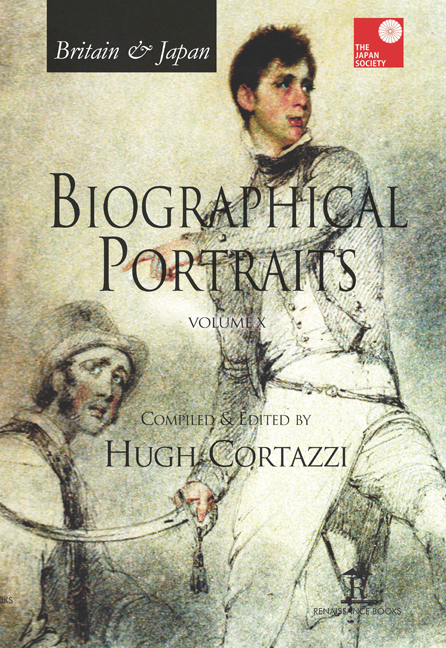Book contents
- Frontmatter
- Dedication
- Contents
- Introduction
- List of Contributors
- Index of Biographical Portraits in Japan Society Volumes
- PART I BRITAIN IN JAPAN
- PART II JAPAN IN BRITAIN
- Select Bibliography of Works in English on Anglo-Japanese Relations [Compiled by Gill Goddard – Retired East Asian Studies Librarian, University of Sheffield]
- Select Bibliography of Works in Japanese on Anglo-Japanese Relations [Compiled by Akira Hirano, SISJAC]
- Index
2 - Thomas (Sir Stamford) Raffles (1781–1826) and Dr Donald Ainslie
Published online by Cambridge University Press: 07 May 2022
- Frontmatter
- Dedication
- Contents
- Introduction
- List of Contributors
- Index of Biographical Portraits in Japan Society Volumes
- PART I BRITAIN IN JAPAN
- PART II JAPAN IN BRITAIN
- Select Bibliography of Works in English on Anglo-Japanese Relations [Compiled by Gill Goddard – Retired East Asian Studies Librarian, University of Sheffield]
- Select Bibliography of Works in Japanese on Anglo-Japanese Relations [Compiled by Akira Hirano, SISJAC]
- Index
Summary
INTRODUCTION
SIR STAMFORD RAFFLES, ‘founder of Singapore’, is a famous historical figure in the history of South-East Asia. His intensive, if brief, engagement with Japan in 1811–15, as Lieutenant-Governor of Java, is less well known. He was then called Thomas Raffles. He turned his middle name into his first in 1817 in time for a knighthood.
Dr Ainslie is quite unknown, and even his name has been confused, since Raffles, who sent him to Nagasaki as British Commissioner, referred to him as ‘David’ although his first name was in fact Donald.
The ‘Adventure to Japan’, as Raffles called it, came to nothing. London was guardedly enthusiastic and the Government of India, under Gilbert Elliot, Earl of Minto, was prepared to be convinced. But in late 1813, Francis Rawson-Hastings, Earl of Moira, took over as Governor-General, and attitudes hardened. The experiment, which included two voyages, yielded nothing, but is nevertheless revealing of attitudes in the period, and dovetails with many significant events. It is a case study in why history seen only through successes will always be incomplete.
Raffles's life is well documented. However little is known of Donald Ainslie. He entered Edinburgh University in 1795, and received an MD in 1801, going straight to Asia, where he was employed by the East India Company as an Assistant Surgeon. Ainslie was thus a few years older the Raffles (who was born in 1781). It seems probable that he was related to Montague Ainslie who had interests in Bengal and so may have invited Anslie to India. After some years there, in late 1807 Ainslie was promoted to Surgeon. By the time he was employed by Raffles, he was Chief Surgeon at Batavia (Jakarta), an office attached to the Binnen hospitaal (‘outer hospital’), or the newer of Batavia's two medical establishments, built in 1743. Chief Surgeons had the role of overseeing sanitation of ships as well as treating on-land patients, so this was a prominent civic position. It is most unlikely that Ainslie would have been employed in this role under the Dutch, so he surely moved to Java in the wake of the English take-over in 1811.
Raffles selected Ainslie because of his status of physician, which was no more than a means to impress the Japanese with his learning.
- Type
- Chapter
- Information
- Britain & Japan Biographical Portraits Vol X , pp. 20 - 36Publisher: Amsterdam University PressPrint publication year: 2016



